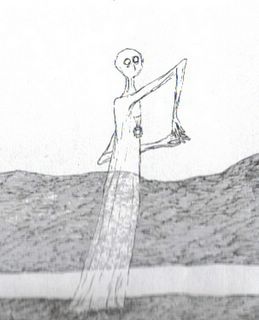According to Wallace Martin (and I don't think he's the only person who believes this) traditional narrative structure (as it occurs in Western culture) follows a standard format: The story starts, tension builds towards a climax or crisis, the climax or crisis occurs, and the story drops off in tension or suspence towards an ending (81).
The problem, as we discussed in class, is that this pattern is far too simple. Very few books or films follow this pattern, and some, like Memento destroy it.
With Memento, a film that I haven't seen before, (I feel a bit like a magician or a tent-preacher, "This person, who I've never met before, nor given any prior instructions to...") we seem to have a story that is cyclical, moving, along with the primary character, Leonard, through a predestined series of steps through a story arch. First we awake, confused and must look around for clues as to where we are and what we're doing. Next we gather, from the various tatoos, notes, pictures, and physical evidence of the area, a gun, a tied up bloody guy, a bottle of booze in our hand, where we are at that instant. Then, following our clues, we add a bit of information, hopefully drawing us a step closer to the conclusion of our quest: finding the man who raped and murdered our wife. (I say "our" and "we" because, following Leonard and hearing his thoughts and, to a certain degree, sharing his memory condition, we identify only with him throughout the film.)
A particularly nice touch to the film is the fact that we start at the end of the quest, having just shot the suspected rapist in the head and then moving backwards, adding the clues that brought Leonard to his conclusion that this particular man is guilty. The disorientation caused by this reversal of instances is ingenious. We "wake" with Leonard in each episodic segment, hoping that we can piece together how we've come to be where we are and what's going on. And, in turn, each episode repeates some facts we already know, but adds a bit of evidence, coloring the conclusions we previously held.
So Memento doesn't follow the standard beginning, rising action, climax, resolution pattern at all. It starts with the climax then runs in circles, backwards, drawing us closer and closer to the "beginning" of the tale.
I haven't seen the whole movie yet, so I don't know how it begins... (And, to me, that's a particularly interesting sensation. I've felt similar sensations with a few movies; Terry Gilliam's Twelve Monkees, Tarantino's Kill Bill, Resevoir Dogs, and, of course, Pulp Fiction, the movie that virtually DEFINED non-traditional narrative structure for this generation...)

